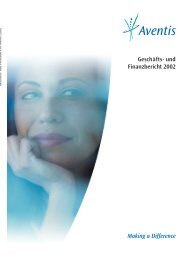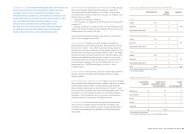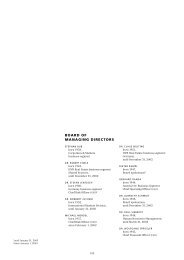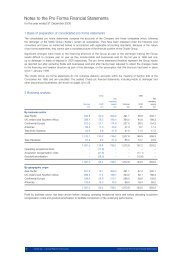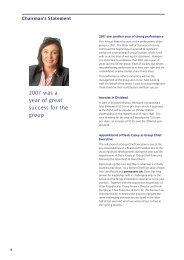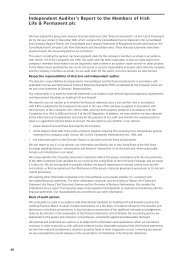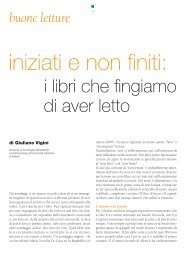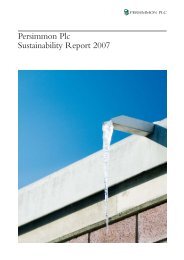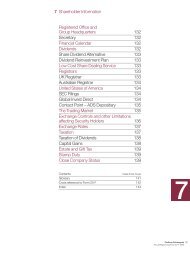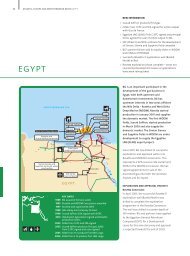Overview of Business Performance - Investis
Overview of Business Performance - Investis
Overview of Business Performance - Investis
Create successful ePaper yourself
Turn your PDF publications into a flip-book with our unique Google optimized e-Paper software.
16<br />
<strong>Overview</strong> <strong>of</strong> <strong>Business</strong> <strong>Performance</strong><br />
life tax reserves.<br />
The adjusted operating return on capital employed<br />
(excluding associate/joint venture and own share<br />
adjustment) was 15.7% at the end <strong>of</strong> 2007 compared to<br />
15.0% achieved in 2006.<br />
Asset Portfolios<br />
Movements in asset values, currencies and interest rates<br />
impact the embedded value <strong>of</strong> the group’s life business<br />
and the mark to market valuation <strong>of</strong> the bank’s liquidity<br />
/ investment portfolios.<br />
Life Assurance Asset Portfolio<br />
The embedded value <strong>of</strong> the group’s life operations<br />
is exposed to market movements in asset currencies<br />
and interest rates due to the fact that the embedded<br />
value is calculated using assumptions regarding future<br />
investment returns and interest rates. To the extent<br />
that actual returns and interest rates differ from the<br />
assumptions used, variances will arise which may be<br />
positive or negative.<br />
As a result <strong>of</strong> the sharp fall in investment markets in the<br />
second half <strong>of</strong> 2007 the actual returns on investment<br />
markets fell signifi cantly short <strong>of</strong> the embedded value<br />
assumptions, resulting in a negative variance on<br />
short-term investment fl uctuations <strong>of</strong> a114m in 2007<br />
compared to a positive a101m experienced in 2006. The<br />
bulk <strong>of</strong> this variance represents the present value <strong>of</strong> the<br />
reduction <strong>of</strong> future fund management fee income from<br />
unit linked funds as a consequence <strong>of</strong> the fall in unit<br />
prices.<br />
In addition, the increase in medium term euro interest<br />
rates has led to an increase in the risk discount rate<br />
used to compute the embedded value from 7.4% to<br />
7.8%. This is the principal reason behind the negative<br />
economic variance <strong>of</strong> a14m recorded in 2007, which<br />
compares to a negative a38m in 2006 when the<br />
risk discount rate increased to 7.4% from 6.5% as a<br />
consequence <strong>of</strong> rising medium term euro bond rates.<br />
The sensitivity <strong>of</strong> the embedded value to changes in<br />
markets is set out in detail in note 14. In summary, a 1%<br />
increase in interest rates reduces the embedded value<br />
by a28m (1.4%) <strong>of</strong> the total embedded value, while a<br />
1% decrease in rates increases the embedded value by<br />
a32m (1.6%). A 10% reduction in equity and property<br />
values would reduce the embedded value by a103m<br />
(5%).<br />
The group’s life business is a relatively low risk<br />
operation. With regard to the unit-linked portfolio <strong>of</strong><br />
a27.9bln, which represents 94% (net <strong>of</strong> reinsurance) <strong>of</strong><br />
the life company liabilities, the investment risk in this<br />
portfolio is primarily borne by the policyholders.<br />
In the non-linked or traditional insurance portfolio<br />
the group’s policy is to match liability fl ows with high<br />
quality assets, principally sovereign bonds. The average<br />
duration <strong>of</strong> the non-linked liabilities is 8.6 years while<br />
the average duration <strong>of</strong> the assets matching these<br />
liabilities is 8.5 years.<br />
The assets held in the fund total a1.7bln and the credit<br />
pr<strong>of</strong>i le <strong>of</strong> the portfolio is as follows:<br />
%<br />
Aaa 70<br />
Aa 23<br />
A 7<br />
100<br />
Given the close duration match, any mark to market<br />
adjustments in the portfolio due to changes in yield<br />
curves are generally matched by equal and opposite<br />
movements in the value <strong>of</strong> the liabilities.<br />
In the year ended 2007 one asset held in the portfolio,<br />
valued at a38m, was subject to an impairment writedown<br />
<strong>of</strong> a8m. Excluding this item there were no other<br />
impairment write-downs in the portfolio.<br />
The life company’s shareholder funds are principally<br />
invested in cash and owner occupied property. A full<br />
analysis <strong>of</strong> the life shareholder fund investments is set<br />
out in Note 5.<br />
Bank Asset Portfolio<br />
The bank’s liquidity portfolio <strong>of</strong> a4.2bln is principally<br />
held in sovereign bonds (59%), highly rated bank FRN’s<br />
(28%) and prime (non-US) euro denominated RMBS<br />
(13%). There are no sub-prime assets held within<br />
the portfolio. The portfolio is rated 73% Aaa, 20%<br />
Aa and 7% A. The mark to market adjustment to this<br />
portfolio at year end was a negative a19m gross which,<br />
in accordance with the IAS39 accounting treatment<br />
applied to “available for sale” assets, was taken to<br />
reserves.<br />
At 31 December 2007, the group held a a2.5bln debt<br />
securities portfolio designated as being “Held to<br />
Maturity”. This portfolio formed part <strong>of</strong> the group’s<br />
holdings with respect to liquidity management. At the<br />
year end the group had the ability and intention to hold<br />
the portfolio to maturity. However, in February 2008,<br />
increased market volatility presented the group with<br />
an opportunity to realise a gain <strong>of</strong> a29m on the sale<br />
<strong>of</strong> the portfolio. The group availed <strong>of</strong> this opportunity<br />
and disposed <strong>of</strong> the entire portfolio. The gain will be<br />
recognised in the 2008 results.<br />
Funding<br />
The regulatory regime under which the bank operates<br />
requires it to have suffi cient liquidity available to cover<br />
100% <strong>of</strong> outfl ows over the next eight days and 90% <strong>of</strong><br />
outfl ows over the next 30 days. Throughout the year the<br />
group operated comfortably within these limits.<br />
The diversifi cation and duration pr<strong>of</strong>i le <strong>of</strong> the group’s<br />
funding sources leave it in a strong position in the<br />
current credit environment. At the year end 64% <strong>of</strong> the



